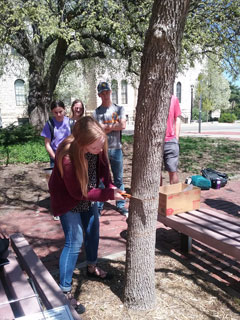April 18, 2019
Using girdled trap trees for detection of emerald ash borer on K-State campus

Walking across campus you may notice something peculiar with a couple of trees. Specifically, two trees; one on the east side of Kedzie Hall and the other on the northeast side of Shellenberger Hall. Both trees display bark removed in a methodical manner about midway up the main trunk, perhaps causing you to wonder, "Who would do this to a tree and why?" Cathie Lavis, professor of horticulture and natural resources, explains.
Kansas State University's Tree Campus USA/Landscape Advisory Committee has been preparing for the imminent arrival of the emerald ash borer. This exotic, invasive insect was discovered in Detroit, Michigan, in 2002 and has since expanded to 31 states. Now eight eastern Kansas counties, including Shawnee County, confirmed the insect's presence two years ago.
The emerald ash borer prefers native and cultivated ash trees of the Fraxinus genus as its host. The larval stage of the insect causes significant damage to the vascular system of the tree by disrupting the trees ability to transport water and nutrients. The damage usually starts in the tree canopy and as the insect population builds within the tree, the damage becomes more severe and more noticeable when canopy dieback, bark cracking and epicormic sprouts occur. Chemical treatment is the only option to protect ash trees from being infested but it must be utilized as a preventative measure before 30% of the canopy is lost due to the insect's damage.
Thanks to the efforts of Kim Bomberger, district community forester at the Kansas Forest Service, and members of the Tree Campus Advisory Committee, K-State now has a five-year strategic emerald ash borer readiness and response plan. The committee is comprised of K-State Facilities cohorts, research/extension and teaching faculty, Manhattan community arborists and arboriculture students.
The goal of the strategic, proactive plan is to acknowledge, manage and minimize the ecological, economic and aesthetic effects that the emerald boar ash will have on the K-State campus. A July 2017 ash tree inventory found 251 trees on the Manhattan campus, of which half were rated in fair condition, 32% in good condition, 18% in poor condition and two trees — or 1% — were dead. No ash trees are present at K-State Olathe. Of the eight ash trees at Kansas State Polytechnic Campus in Salina, five trees are in poor condition, two fair and one in good condition. This readiness and response plan is intended to proactively guide the university in advance of and during an infestation of the emerald ash borer. This proactive strategy balances the removal and planting of trees. Removal of poor and fair conditioned ash trees started last fall. This plan has been implemented in a five-year time frame, with review after five years to evaluate management needed in the next five-year cycle.
Studies conducted by Michigan State University and the USDA Forest Service suggest that girdled ash trees are an effective detection tool for the insect. Emerald ash borer adults are attracted to stressed ash trees and lay more eggs on stressed versus healthy trees. Girdling ash by removing the bark and phloem around the entire circumference of the trunk, creates an effective attractant for the insect. The trees selected for this process are rated in poor to fair condition. The two ash girdled this week during arboriculture lab classes, with the guidance of Jeff Vogel and Taro Eldredge from the Kansas Department of Agriculture, will be allowed to stand for a growing season and then will be removed for processing during the fall semester. Although girdling and bark peeling are labor-intensive and involve the sacrifice of live trees, girdled trap trees are a good option for detection of the emerald ash borer.
Last fall, the two ash trees girdled in front of Dole Hall in spring 2018 were processed by horticulture students, along with Vogel. Students learned how to remove all of the bark on specific sections of the tree trunk and upper branches while searching for any larval feeding galleries and the insect's life stages. We did not detect any emerald ash borer in either tree.
The trees girdled this spring, will be peeled next fall in Landscape Maintenance lab classes. By turning this into an educational opportunity for our campus community, we are attempting to find the "silver lining" of the tremendous loss of our beloved trees. Students not only learn about the emerald ash borer, they gain skills that equip them for their futures that may involve similar issues.
